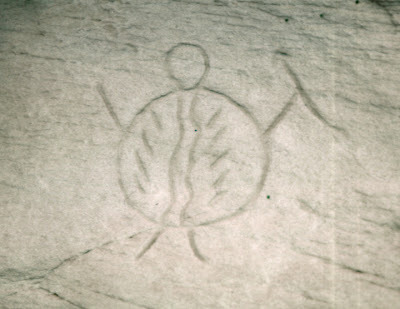Thomas Wharton's Blog, page 3
March 19, 2013
Writing on Stone

One of my favourite places on the planet is Writing-on-Stone historic site, in the extreme south of the province. It’s a magnificent landscape, first of all, with a view across the Milk River of the Sweetgrass Hills of Montana rising out of the plain. At sunrise and sunset in this valley the colours of the bands of rock strata rock light up and glow with an otherworldly beauty.
And then there are the petroglyphs and pictographs, the drawings and paintings on the faces of the rock. The Blackfoot call this place Áísínai’pi, meaning “it is written” (or “it is pictured”). Aboriginal people see this valley as a home to powerful spirits, and many of the carvings in the rock depict encounters with these beings. But the carvings also commemorate historical events, such as the arrival of horses and Europeans to the area.
When Sharon and I first visited here, before we were married, we arrived on a sizzling hot day, the heatsink of summer in southern Alberta. We nearly ran over a rattlesnake (well, a snake, anyhow) basking in the middle of the road. We were parched, but as we were camping in a tent on the flats, there was little relief from the heat. We clambered among the rocks, marveling at the art we found. I saw a figure with its arms raised to the sky, and over its head a line in an arc, like a rainbow. I didn’t take a picture of it, and I’ve never seen it reproduced in any articles or websites that I’ve found since about the park.
In the evening, a huge dark wall of cloud rose in the west. Briefly the clouds broke and sunset fell across the world like a path of gold. We could see the tiny shapes of pronghorn antelope dotting the plain, miles away, like stars. Then the clouds closed back in and that night a torrential rainstorm was unleashed on the valley. Our tent was flooded and nearly washed away. It looked as if we’d managed to camp in a dried-up creekbed.
The next morning, cold, soaked and miserable, we left the park and stopped for gas in the nearby town of Milk River. The attendant, an older man, said they hadn’t had a storm like that here for years. Which was more proof to us that we should hire ourselves out as rainmakers, since wherever we go when we’re tenting, no matter how unlikely the chance of precipitation, there’s sure to be a downpour.
I came back to Writing-on-Stone years later with a writer friend. This time we took a guided tour with a group of other visitors. The guide showed us some of the rock art, and told us what was known about it. He also carefully explained that the art, while it might look crude by contemporary standards, was not meant to be representational but was highly symbolic and stylized, as much a script as it was pictorial. Hence the name Writing on Stone. This idea didn’t sink in with one of the other tourists, who pondered the carvings with the rest of us and then, at the end of the tour, loudly gave his verdict: “Man, them Indians sure couldn’t draw good.”

Published on March 19, 2013 06:35
March 18, 2013
The storyteller is the story
This image by the Dutch artist Cor Blok shows Gandalf (the White, after his death and resurrection) relating the story of his battle with the balrog to Aragorn, Legolas and Gimli. On the wizard’s body one can see various episodes from his chase and struggle with the balrog, from the lowest depths of Moria, where strange creatures dwell in the darkness, up the Endless Stair, to the highest peak of Silvertine. Gandalf’s conical hat doubles as the peak on which he wrestles with his enemy and finally casts him down, after which he is rescued by the eagle Gwaihir the Windlord.
When I first encountered Blok’s illustrations for Tolkien’s work, I wasn’t sure what to think of them. They’re not at all in the heroic mode of artists like the Brothers Hildebrandt, which was the art I first encountered on calendars and the like when I first fell in love with Tolkien’s work in the 1970’s. I liked illustrations that matched the grand, epic feel of the book. Blok’s work looked a little too, well, childish.
It was this particular image that won me over to Blok’s vision of The Lord of the Rings. It’s a vision that doesn’t try to illustrate so much as suggest. And what this particular image suggests to me is the archetypal figure of the Storyteller.
There’s a truth about storytelling depicted here: that the story and the storyteller are really one. A story is not something a storyteller just spins out of nothing, or reels off like a tape recorder. Storytellers carry their stories with them, sometimes for many years, and the shape and events of their lives help to shape their stories. The same story told by three different storytellers would of course become three very different stories. Just as a dancer is her dance, a storyteller is his stories. And this is true of all of us, even if we don’t think of ourselves as storytellers.
For me, the fact that my stories are part of me, physically, is most obvious when the story I have to tell is a difficult or painful one. At those times, like Gandalf wrestling with the balrog, I can feel myself, my body, struggling to get the story out.
Try this: the next time someone tells you a story, even if it’s just an “ordinary” story about the odd encounter they had on the bus this morning, or the dumb thing their cat did yesterday, pay close attention to how the person’s body contributes to the telling: facial expressions, gestures, movements. Sometimes you notice that the story the person is telling with their words is not at all the same story their body is telling.
The next time you tell someone a story, notice where in your body the story seems to be coming from -- it might not be just from inside your head.
When I first encountered Blok’s illustrations for Tolkien’s work, I wasn’t sure what to think of them. They’re not at all in the heroic mode of artists like the Brothers Hildebrandt, which was the art I first encountered on calendars and the like when I first fell in love with Tolkien’s work in the 1970’s. I liked illustrations that matched the grand, epic feel of the book. Blok’s work looked a little too, well, childish.
It was this particular image that won me over to Blok’s vision of The Lord of the Rings. It’s a vision that doesn’t try to illustrate so much as suggest. And what this particular image suggests to me is the archetypal figure of the Storyteller.
There’s a truth about storytelling depicted here: that the story and the storyteller are really one. A story is not something a storyteller just spins out of nothing, or reels off like a tape recorder. Storytellers carry their stories with them, sometimes for many years, and the shape and events of their lives help to shape their stories. The same story told by three different storytellers would of course become three very different stories. Just as a dancer is her dance, a storyteller is his stories. And this is true of all of us, even if we don’t think of ourselves as storytellers.
For me, the fact that my stories are part of me, physically, is most obvious when the story I have to tell is a difficult or painful one. At those times, like Gandalf wrestling with the balrog, I can feel myself, my body, struggling to get the story out.
Try this: the next time someone tells you a story, even if it’s just an “ordinary” story about the odd encounter they had on the bus this morning, or the dumb thing their cat did yesterday, pay close attention to how the person’s body contributes to the telling: facial expressions, gestures, movements. Sometimes you notice that the story the person is telling with their words is not at all the same story their body is telling.
The next time you tell someone a story, notice where in your body the story seems to be coming from -- it might not be just from inside your head.
Published on March 18, 2013 06:07
March 15, 2013
Camping

On a stretch of flat scrubby ground along the Miette River, just outside of town, the park authorities had set aside space for travelers passing through Jasper who could not afford campground fees. The free camp, as it was known, had become a gathering place for young people with nowhere to go, drifters, wanna-be Jack Kerouacs, drop-outs, and potheads. We called them shrubs. The shaggy, scrawny boys with guitars and no shirts. The fever-eyed, barefooted girls you would sometimes see in the freezer aisle of the grocery store, slipping packages of sandwich meat under their shirts or into their woven shoulder bags (the girls were sent in to do the shoplifting because they were less likely to be suspected and thus caught).
The free camp was a place that the kids who lived in Jasper talked about with a kind of fear and fascination. You didn’t go out there unless you were looking for adventure, or trouble, or dope. One evening a friend who’d been to the camp talked some of us who hadn’t into going with him. If we were lucky, our friend said, one of the shrubs would share a joint with us. We could get high. Most of us had never done that.
We didn’t find anyone smoking pot, or willing to share it with us. But we sat and talked for a while with a guy named Rob who was idly strumming a guitar. Rob looked like Jesus. He had the long hair, the little beard, and a laid-back, amiable manner. Rob never smoked pot or took any drugs, or so he said (he seemed to guess that’s why we had come here in the first place). He told us that he would never use any artificial means of heightening consciousness, since, if a person really paid attention, they would know that one’s consciousness was already, always, heightened.
He had been a physics grad student at CalTech, and now he was traveling the continent. Everything is friction, he said. The contact of surfaces, generating heat, light, sound, all of the information we get about the world around us. But this information comes at a price, since something always gets lost as a result of friction. Surfaces wear down. Heat dissipates into the surround. The signal degrades. Things fall apart. Only one thing in the universe can act on everything else without friction of any kind.
“Do you know what that is?” he asked us. We wracked our brains. We didn’t know.
“The mind,” Rob said.
He talked a lot about the mind then, and I don’t remember most of it, because I didn’t get most of it. He may have mentioned William Blake. I'm not sure. But he did say one thing, just before we left, that stuck with me.
“You know,” he said, “we’re all camping. All of us. You, me, everyone.”
We asked him what he meant. Again we didn’t get it.
“We’re just camping,” he said, shrugging his shoulders and smiling his Jesus smile. “Some of us stay in the same spot for a long time, but a house isn’t any different from a tent. Not really. You’re just borrowing that spot for a while, from nature. From the universe. And one day you’ve got to move on.”
A few years later the park authorities closed the free camp because of its reputation as a drug hang-out. It never reopened.

Published on March 15, 2013 06:24
March 13, 2013
Happy Hamster and the Dream Police
Published on March 13, 2013 07:42
March 11, 2013
The Darkness: A Love Story
What if tonight, when you’re scared and alone, with one arm hanging off the edge of your bed, the darkness reaches up and holds your hand?
What if, instead of pulling back in fear, you hold onto the hand of darkness, and you tug. And what if you drag the darkness out from underneath the bed. It struggles and kicks, but you don’t let go. You drag it up onto your bed and throw your arms around it so that it can’t escape. You can hear both your heart and its heart pounding in fear but you don’t let go. And finally the darkness gives up the struggle and goes quiet.
Why did you touch my hand? you demand, trying to keep the fear out of your voice. Why are you always lurking down there, trying to scare the hell out of me?
The darkness doesn’t answer. Instead, it reaches out a hand you cannot see and touches your face. It’s a gentle, hesitant touch. The fingers of the darkness are cold, but not with malice, you realize. They are cold with fear, and longing.
The hand of the darkness moves again, takes your hand gently, and moves it to its own heart. You feel its heart beating frantically against your palm.
Heart of darkness, you think. Like that story you had to read in high school, about the crazy guy up a river in Africa. You didn't get that story. Why did the guy have to go up a river to find darkness? You can find it anywhere. Like under your bed.
But that was before. When you thought darkness was your enemy. You know now what the darkness has felt all these nights, huddled under your bed, alone and longing and waiting but terrified also that this night would come. This night when you would finally meet face to face and the darkness would be forced to confess how it really feels about you. How much it needs you.
You pull your hand away. You’re afraid again, but not the same way as you were before. You want the darkness gone. You want it back where it was before, when it was the unknown. When it was the place you could fill with everything you were afraid of. And the darkness knows this. It moves away from you. It stands beside your bed, with no face that you can see. No eyes. No sign that you can read to tell you how it's feeling.
There’s a low rumbling from the darkness beyond the darkness. Then a pair of dim lights appear and grow. A vehicle of shadows pulls up beside your bed and stops. On its roof is a glowing silver disk, and on its side, in phosphorescent letters, the word Nightcab.
The darkness climbs into the backseat and the Nightcab drives off. You’re still sitting in your bed, and there’s light coming in through the window. A grey light, like dirty dishwater. It will be morning very soon. Time to get up and get ready for work.
What if, instead of pulling back in fear, you hold onto the hand of darkness, and you tug. And what if you drag the darkness out from underneath the bed. It struggles and kicks, but you don’t let go. You drag it up onto your bed and throw your arms around it so that it can’t escape. You can hear both your heart and its heart pounding in fear but you don’t let go. And finally the darkness gives up the struggle and goes quiet.
Why did you touch my hand? you demand, trying to keep the fear out of your voice. Why are you always lurking down there, trying to scare the hell out of me?
The darkness doesn’t answer. Instead, it reaches out a hand you cannot see and touches your face. It’s a gentle, hesitant touch. The fingers of the darkness are cold, but not with malice, you realize. They are cold with fear, and longing.
The hand of the darkness moves again, takes your hand gently, and moves it to its own heart. You feel its heart beating frantically against your palm.
Heart of darkness, you think. Like that story you had to read in high school, about the crazy guy up a river in Africa. You didn't get that story. Why did the guy have to go up a river to find darkness? You can find it anywhere. Like under your bed.
But that was before. When you thought darkness was your enemy. You know now what the darkness has felt all these nights, huddled under your bed, alone and longing and waiting but terrified also that this night would come. This night when you would finally meet face to face and the darkness would be forced to confess how it really feels about you. How much it needs you.
You pull your hand away. You’re afraid again, but not the same way as you were before. You want the darkness gone. You want it back where it was before, when it was the unknown. When it was the place you could fill with everything you were afraid of. And the darkness knows this. It moves away from you. It stands beside your bed, with no face that you can see. No eyes. No sign that you can read to tell you how it's feeling.
There’s a low rumbling from the darkness beyond the darkness. Then a pair of dim lights appear and grow. A vehicle of shadows pulls up beside your bed and stops. On its roof is a glowing silver disk, and on its side, in phosphorescent letters, the word Nightcab.
The darkness climbs into the backseat and the Nightcab drives off. You’re still sitting in your bed, and there’s light coming in through the window. A grey light, like dirty dishwater. It will be morning very soon. Time to get up and get ready for work.
Published on March 11, 2013 08:03
March 7, 2013
The Council of Elrond

I’ve read The Lord of the Ringsnow to all three of my kids, one after the other. Or I should say, I’ve started to read the book to them, but with all three, the reading got stalled at the same chapter.
I want to say that I lovereading Tolkien’s work out loud. I enjoy giving each character a particular vocal style or accent. I like the way that reading out loud makes me slow down and appreciate the careful, loving craft and thought that went into this story. And I love declaiming Tolkien’s beautifully-crafted, powerful sentences. Many of which can be found in the particular chapter in question, where I get to do many different voices.
Yes, I'm talking about “The Council of Elrond.” A very long chapter that describes a meeting. That’s right, the thing that most people hate more than just about anything at their jobs: meetings. Tolkien has a lot of backstory to get through, and a lot of characters to introduce. And he has to do it in a scene where a bunch of noble, long-winded adults sit around and talk. And talk. And talk.
To Tolkien’s credit I think this chapter is magnificent. The language is eloquent, ringing, rousing. The chapter is structured, too, in such a way as to only reveal a little bit at a time, keeping a reader engaged and wanting to know more, and also building slowly and inexorably to the fundamental problem that this meeting is meant to address: what to do with the ring, and who is going to do it?
If Middle Earth was like our world, before long the central purpose of the meeting would have been diverted into unhelpful channels by those insisting on having their own agenda heard, no matter how unrelated it is to the matter at hand. People would get restless, annoyed, bored. Eventually Elrond would have to call for a subcommittee or focus group to look into the problem of what to do about the ring. Then there would be a motion to continue the discussion on another day and everyone would flee back to their cubicles to scarf down a compensatory donut.
Anyhow, the challenge with reading this book to my kids was always to get them past “The Council of Elrond.” Children have no use for a bunch of adults, especially serious, noble, long-winded adults, sitting around talking about important stuff. My two older kids didn’t make it past this chapter. It reduced them to a state of catatonia. The reading ground to a halt somewhere around Gandalf’s long story of how he escaped from Saruman, and we never continued.
My third and youngest (hmm, just like in the fairy tales?) made it all the way through “The Council of Elrond” with me. I was surprised. I was thrilled. Then he announced he didn’t want to read the book anymore. Disappointed, I didn’t say much. I’d learned to bide my time with this one and not insist on my own agenda. Sure enough, a little later he told me that we could keep reading the book, if I really wanted to. You know, as a favour to me.
So we’ll carry on. And we should be good. Until we get to Treebeard…

Published on March 07, 2013 07:02
March 5, 2013
Strangers on a plane

On a long plane flight you spend hours in close proximity with people you don’t know. You may exchange a few words with some of them (“excuse me”, “thank you” etc), and sometimes you strike up a real conversation with someone, but most of these strangers remain complete strangers. Except for their faces.
People get up from their seats more, to go to the bathroom, to exercise atrophying muscles, to look at something other than the back of the seat ahead of them. Some passengers spend most of a flight standing in the aisle, chatting with each other or with the flight attendants. As a result you get familiar with their faces, and a few of these faces stand out as more interesting, or bothersome, than others. Sometimes because of uncommon beauty, or uncommon ugliness. Or something else that intrigues you. A face that suggests nobility. Intensity. A haunted look. A face of complete vacancy. There are faces you compulsively return to for another look, sometimes to the point where they cease being faces altogether and become invested with your own private meanings that their owners could never guess at. You make up stories about the life lived by the owner of that particular face. An attractive face stands in for the allure of the elsewhere that you’re headed for. A face that repels or irritates you comes to represent the tedium and discomfort you’re enduring to reach that elsewhere(and thus there’s a special pang seeing the owner of one of these “tedium” faces getting through customs ahead of you, free, while you’re still stuck in transitland). The obvious remedy, of course, is to glance behind you and see one of those faces even further than you from the portals of liberty. And about the time you start doing that, you also realize how petty and mean-spirited one can get after an entire day of air travel.
Of course you can have the same experience on other forms of transportation. On our honeymoon, Sharon and I went to Ireland. On the west coast we took the ferry to the Aran Islands. It was a windy, choppy day and most of the passengers were pretty subdued, many of them huddled in the misery of seasickness. There was one tall older man, however, who stood gazing out over the waves, seemingly unaffected by the rough sailing, the breeze catching his fine, longish white hair. He had a red scarf around his neck. He struck me as someone very unusual and interesting, someone I’d like to get to know.
When we arrived on the island, the tall man and his son took the same pony cart as Sharon and I, and it turned out they were staying at the same bed and breakfast place we were. That evening at dinner we shared a table in the B & B. The man introduced himself and his son, Noah. He was Robert Bly, the poet and author of Iron John.

Published on March 05, 2013 06:22
February 28, 2013
Instant Pulp: Just Add Water
<!-- /* Style Definitions */ p.MsoNormal, li.MsoNormal, div.MsoNormal {mso-style-unhide:no; mso-style-qformat:yes; mso-style-parent:""; margin:0cm; margin-bottom:.0001pt; mso-pagination:widow-orphan; font-size:12.0pt; font-family:"Times New Roman"; mso-fareast-font-family:"Times New Roman"; mso-fareast-language:JA;} .MsoChpDefault {mso-style-type:export-only; mso-default-props:yes; mso-fareast-font-family:"MS 明朝"; mso-fareast-theme-font:minor-fareast; mso-fareast-language:JA;} @page WordSection1 {size:612.0pt 792.0pt; margin:72.0pt 90.0pt 72.0pt 90.0pt; mso-header-margin:35.4pt; mso-footer-margin:35.4pt; mso-paper-source:0;} div.WordSection1 {page:WordSection1;} </style> <br /><div class="separator" style="clear: both; text-align: center;"><a href="http://2.bp.blogspot.com/-z1UqlShYMDE..." imageanchor="1" style="margin-left: 1em; margin-right: 1em;"><img border="0" height="400" src="http://2.bp.blogspot.com/-z1UqlShYMDE..." width="335" /></a></div><div class="MsoNormal" style="line-height: 150%;"><br /></div><div class="MsoNormal" style="line-height: 150%;"><br /></div><div class="MsoNormal" style="line-height: 150%;"><span style="font-size: large;"><span style="line-height: 150%;">My writing students found out it was my birthday recently and today in class they presented me with a surprise gift: a book they’d made for me called Instant Pulp: Just Add Water. Subtitled “Ideas for a stopped and stalled creative mind.”</span></span></div><div class="MsoNormal" style="line-height: 150%;"><br /></div><div class="MsoNormal" style="line-height: 150%;"><span style="font-size: large;"><span style="line-height: 150%;">I was very touched. I don’t know where they got the idea that I might be stalled creatively (yeah, my daily writing habit has been a bit sluggish lately but how would they know that…?) but anyhow Instant Pulp is a delight. The students had passed a little blank notebook around amongst themselves and filled it with story starters, writing prompts, scenarios, bon mots, and encouragements. There are some really brilliant, juicy ideas in this wee tome, and at least one so far that strikes me as the solution to a long-standing problem I’ve been having with a particular story. An idea I should’ve had myself but didn’t, and now here it is. Fiat lux! This truly is a gift. </span></span></div><div class="MsoNormal" style="line-height: 150%;"><br /></div><div class="MsoNormal" style="line-height: 150%;"><span style="font-size: large;"><span style="line-height: 150%;">I made sure to ask the students if by giving me this book they were giving me the right to use any of this material in my own work. They said yes, that was fine, although one of them added “We kept our really good ideas for ourselves.” They only asked that if any of the ideas in Instant Pulp proved to be the seed of a book that I should thank them in the acknowledgements. Fair enough.</span></span></div><div class="MsoNormal" style="line-height: 150%;"><br /></div><div class="MsoNormal" style="line-height: 150%;"><span style="font-size: large;"><span style="line-height: 150%;">I’ve decided to start by taking a couple of the writing prompts and using them to generate stories for this blog. So that’s what’s coming up soon here on “Notes for the Perilous Realm.” </span></span></div><div class="MsoNormal" style="line-height: 150%;"><br /></div><div class="MsoNormal" style="line-height: 150%;"><span style="font-size: large;"><span style="line-height: 150%;">Since I can’t tell for certain from the handwriting who wrote which prompts, I won’t be able to credit people individually for each idea as I use them on the blog, so I will just say a collective thank you, students of Write 395, 2012-13. And don’t forget to read the story I assigned for next class.</span></span></div><div class="MsoNormal" style="line-height: 150%;"><br /></div><div class="MsoNormal" style="line-height: 150%;"><br /></div><div class="blogger-post-footer"><img alt="StumbleUpon" src="http://www.stumbleupon.com/images/stu..." border="0" /></div>
Published on February 28, 2013 07:59
February 27, 2013
The ending of the Great Dark

The moths have a legend:
Once, long ago, the Great Dark was lit by a single divine moth called the Shine. Forever out of reach, the Shine guided all moths in the darkness, helping them find their way when they went on their journeys of feeding and mating. The Shine looked down with love on all moths, until she was forced to hide and rest when the deadly burning Eye rose into the sky and vanquished the Great Dark. All mothkind joined her in rest, hiding from the heat and fierceness of the Eye until it fell again and the Great Dark returned.
This was the life of all mothkind, until the event known as the Falling. No moth knows for certain why it happened, but the tiny lights called the stars fell from the Great Dark. They were no longer high up in the sky, like the Shine, but could be reached, could actually be touched by moths in flight, which caused much wonder and confusion. There were some moths who claimed that the Shine had divided herself and come among them out of love for all mothkind. They would hover around these lesser lights, seeking communion with the Shine, until they perished from exhaustion. Some of the lesser lights themselves would kill moths when they touched them, and it was claimed by some that their souls had been taken up instantly by the Shine into the Great Dark, while others argued that these were false lights, sent by the evil Fire to trick and kill moths. All that anymoth could say for certain was that the Great Dark was no longer ... dark. And if the Great Dark was no longer dark, then what was it? And what could be trusted?
In a previous post I talked about the urge we often have to tell each other stories when darkness falls. Especially if there aren’t any lights or distractions handy, like televisions or smartphones or other devices offering instant, disposable entertainment. In another post I talked about how we all become storytellers in the dark when we sleep and dream. Once the daylight mind relaxes and gives in to the free play of the subconscious, most of us are far more creative than we usually give ourselves credit for.
Anyhow the point I want to make is that there’s some mysterious deep connection between stories and darkness. When we’re kids and our parents wish us a good night and turn out the light, we immediately people the dark with all kinds of imagined terrors, weaving scary stories about the creatures lurking under the bed. In his introduction to the Pantheon edition of the Fairy Tales of the Brothers Grimm, Padraic Colum says, “In the place where the storyteller was, the coming of night was marked as it was not in towns nor in modern houses. It was so marked that it created in the mind a different rhythm. There had been a rhythm of the day and now there was a rhythm of the night….”
Colum goes on to talk about the way that modern electric light allowed us to extend the day’s rhythm far into the night, and how the art of the storyteller faded when this happened. But these days when it gets dark we still have the urge to gather around light, like moths, and we still usually seek out stories, too. And we get both in the lighted screen of the television, or the computer, though this radiant, tireless, impersonal storyteller doesn’t know us, doesn’t know our names or our own stories.

Published on February 27, 2013 06:25
February 25, 2013
The gentle time machine

I turned fifty today. On the one hand, I can’t believe I got here already. Half a century. When I was a kid fifty seemed like an ancient age for someone to be. But now, big surprise, it doesn’t seem so old.
I’ve discovered over the years that one’s calendar age isn’t some monolithic truth. That really as you get older you carry all your younger selves around with you. And even when you’re very young, the person you’ll be at fifty, or ninety, is already there. After all, when I was ten I didn’t feel young. I felt I was who I was supposed to be. And it’s the same now.
And besides, I can console myself with the thought that fifty is the age at which both Bilbo and Frodo first set out on their great adventures. In fact fifty seems like a good age to start something new. Maybe something unexpected and uncharacteristic. Looking back on my life so far I realize that one of the things I’m most happy about is that I haven’t lost the desire to play. At least once in a while. I haven’t completely put away childish things, like the world expects me to.
I had a curious dream last night that probably has something to do with the fact that I’ve been thinking more than usual lately about my age. I was at a county fair, and saw a booth advertising “The Gentle Time Machine” of somebody called Doctor Misterius. I went in. The doctor was a tall thin man, and his time machine was nothing more than a small box with a single red button on top.
“Press the button and be miraculously transported into another moment in time,” the doctor said. So I did.
“Some miracle,” I said. “Nothing happened.”
“No?” the doctor asked. “When are you now?”
I thought about it and understood.
“Your time machine is time itself,” I said. “It’s always bringing us gently into the next moment.”
Well, the realization seemed profound when I was dreaming it.
Is time a miracle? If we don’t take it for granted, maybe it is.

Published on February 25, 2013 06:48




